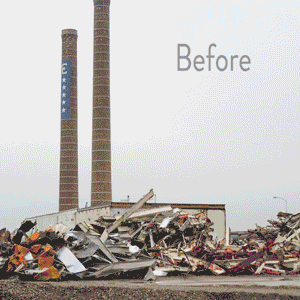Former Superfund Site in Fridley Transitions into Award-winning Redevelopment Project
8/7/2018 1:00:00 PM

It’s not often a redevelopment project in Minnesota requires sustained resources and multiple DEED Contamination Cleanup and Investigation grants.
But the sheer size and complexity of this 122-acre Fridley industrial project – originally the Naval Industrial Reserve Ordnance Plant (NIROP) site – now known as Northern Stacks – was so rare it had to be completed in multiple phases. Each phase received its own Contamination Cleanup Grant.
DEED, the City of Fridley Housing and Redevelopment Authority (HRA), Paul Hyde of Hyde Development, and other entities involved in the project have closely monitored the development’s progress over the last six years.
DEED has awarded a total of $5,814,500 to assist in cleaning up the former NIROP site. DEED funds helped pay for the cost of site investigation, development of the cleanup plan, demolition, stormwater pond liners to eliminate infiltration, groundwater monitoring system modifications, active vapor system design and installation, contaminated soil management, and environmental oversight and reporting. The Metropolitan Council, Fridley HRA TIF, and the developer provided matching funds to the grants.
Once all phases of the development are complete, anticipated economic benefits include:
Prior to the 1940s the property was used as cropland. As World War II loomed, the site was developed with a 2 million square-foot building used for manufacturing gun mounts and missile launching systems for the U.S. Navy. Over 7,000 men and women worked around-the-clock to supply America’s war effort. Playing a critical role in every war since World War II, heavy manufacturing continued at the site for the next 70 years and received six Navy E awards for excellence. In 2012, at a time when a majority of the building was vacant, Fridley Land LLC, a development entity of Hyde Development, purchased the property for redevelopment.
Paul Hyde and Paul Bolin, assistant executive director of Fridley’s HRA, approached the business park project with many of the same goals.
“Nearly everyone in Fridley had family or neighbors that worked on the site at some point,” Bolin said. “Residents are well aware of the environmental contamination that happened over the years and are supportive of the efforts to clean the site and bring jobs back to the community,” Bolin said.
“Our goal is to create a business park that includes a wide variety of businesses,” Hyde said. A diverse set of tenants that includes medical technology, distribution, manufacturing, defense and entertainment provides a sustainable economic base for Fridley and the region and contributes to the project’s success. Flexible, well-designed and well-constructed buildings is the key.”
Steady Contamination and Cleanup grants from DEED made the project happen. “This was the piece that allowed the project to move forward,” Bolin said. “If this funding for Northern Stacks had not been available, I don’t believe the project would have been possible.”
Today, Bolin and Hyde report a dramatic increase in tax base and the return of thousands of jobs to the East River Road site. Seven Northern Stacks buildings are completed or near completion on the former NIROP site. Tenants include:
Navy E awards are still displayed on the site’s historic smokestacks.
The project has the attention and admiration of the development community, having won the Business Journal-Best in Real Estate award, NAIOP Award of Excellence (Commercial Real Estate Development Association), and MN Brownfields ReScape Award. Now Hyde Development is redeveloping a neighboring building (Northern Stacks VIII) as a result of market demand.
In the most recent round of cleanup funding, the Fridley HRA was awarded $432,000 for nearly 12 acres directly north of the former NIROP site. Historically used for dumping and filling, and most recently for printing and storage, redevelopment plans call for renovating an existing 180,000-square-foot building for office/warehouse purposes.
Once Northern Stacks VIII is completed, anticipated benefits include 18 new and 82 retained jobs and an increase to the tax base by $185,619.
Cleaning up contaminated sites is good for the environment and the economy. The projects create jobs, attract private investments and generate new tax revenue for Minnesota cities.
DEED Cleanup grants can pay for up to 75 percent of the costs associated with remediating brownfields statewide. The remaining 25 percent typically comes from a mix of other grant sources, contributions from the applicant, and the developer.
Since the program began in 1995, 507 grants totaling $180 million have been awarded. Thanks to the funding, 3,587 acres of contaminated property have been reclaimed for development projects, resulting in 22,978 new jobs and 26,371 retained jobs. The program has attracted $7 billion in private investments and generated $126 million in new tax revenue.
“Our programs are in demand, because it is especially expensive to develop sites after decades of industrial use,” said Kristin Lukes, director, Brownfields and Redevelopment for DEED. “Developers and cities can rely on the Contamination Cleanup and Investigation Grants program to make their redevelopment projects viable and successful.”
Photo credit: Hyde Development
Economic Development